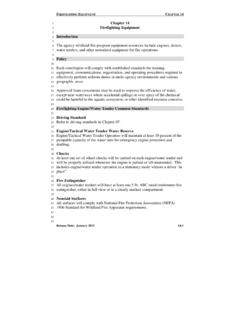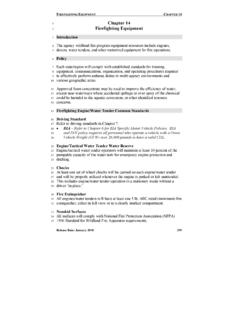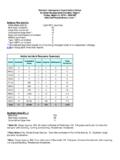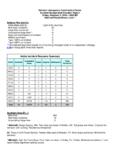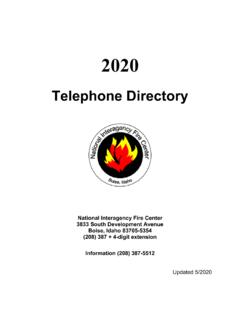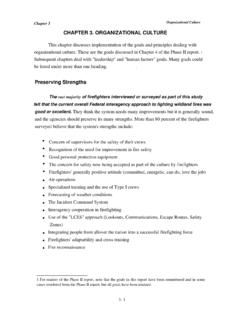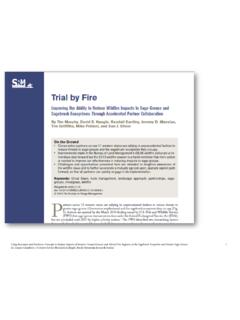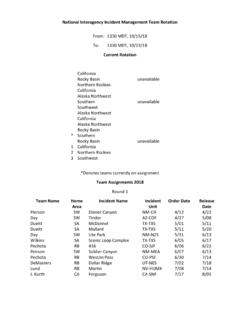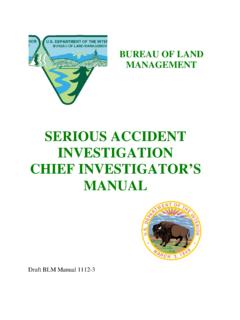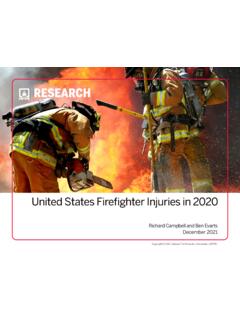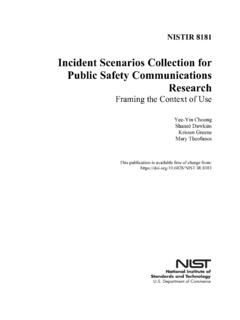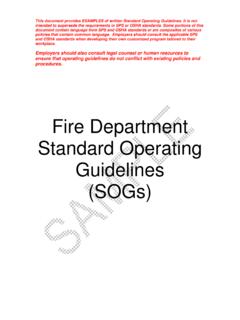Transcription of Wildland Fire Incident Management Field Guide
1 A publication of the National Wildfire Coordinating Group Wildland fire Incident Management Field Guide PMS 210 April 2013 Wildland fire Incident Management Field Guide April 2013 PMS 210 Sponsored for NWCG publication by the NWCG Operations and Workforce Development Committee. Comments regarding the content of this product should be directed to the Operations and Workforce Development Committee, contact and other information about this committee is located on the NWCG Web site at Questions and comments may also be emailed to This product is available electronically from the NWCG Web site at Previous editions: this product replaces PMS 410-1, Fireline Handbook, NWCG Handbook 3, March 2004. The National Wildfire Coordinating Group (NWCG) has approved the contents of this product for the guidance of its member agencies and is not responsible for the interpretation or use of this information by anyone else.
2 NWCG s intent is to specifically identify all copyrighted content used in NWCG products. All other NWCG information is in the public domain. Use of public domain information, including copying, is permitted. Use of NWCG information within another document is permitted, if NWCG information is accurately credited to the NWCG. The NWCG logo may not be used except on NWCG-authorized information. National Wildfire Coordinating Group, NWCG, and the NWCG logo are trademarks of the National Wildfire Coordinating Group. The use of trade, firm, or corporation names or trademarks in this product is for the information and convenience of the reader and does not constitute an endorsement by the National Wildfire Coordinating Group or its member agencies of any product or service to the exclusion of others that may be suitable. Wildland fire Incident Management Field Guide i PREFACE The Wildland fire Incident Management Field Guide is a revision of what used to be called the Fireline Handbook, PMS 410-1.
3 This Guide has been renamed because, over time, the original purpose of the Fireline Handbook had been replaced by the Incident Response Pocket Guide , PMS 461. As a result, this new Guide is aimed at a different audience, and it was felt a new name was in order. 0 BPurpose The Wildland fire Incident Management Field Guide states, references, or supplements Wildland fire Incident Management and operational standards established by the National Wildfire Coordinating Group (NWCG). 1 BRelationship to the Incident Response Pocket Guide and Emergency Responder Field Operations Guide This Field Guide contains some information that is duplicated in the Incident Response Pocket Guide (IRPG) and the Department of Homeland Security, Federal Emergency Management Agency (FEMA), National Incident Management System Emergency Responder Field Operating Guide (ERFOG), but the documents have different purposes and user groups.
4 This Field Guide is the standard NWCG Incident Management reference Guide . The IRPG is the Wildland fire job aid and training reference for operational personnel from Firefighter Type 2 through Division Supervisor and Initial Attack/Extended Attack Incident Commander, and is primarily an initial responder s tool. The ERFOG provides guidance designed to assist emergency response personnel in the use of the National Incident Management System (NIMS) Incident Command System (ICS) during Incident operations and is primarily a Command and General Staff tool. 2 BRevision Process This Field Guide will be revised every 5 years. To recommend changes to the document, contact your agency representative on the Operations and Workforce Development Committee (OWDC). Information about this committee is located on the NWCG Web site at The Field Guide is available electronically and is formatted for printing on standard 8 x 11-inch paper.
5 Ii Wildland fire Incident Management Field Guide Wildland fire Incident Management Field Guide iii TABLE OF CONTENTS PREFACE .. i 0 BPurpose .. i 1 BRelationship to the Incident Response Pocket Guide and Emergency Responder Field Operations Guide .. i 2 BRevision Process .. i TABLE OF CONTENTS .. iii CHAPTER 1 FIREFIGHTING SAFETY .. 1 Risk Management .. 1 Tenets of a High Reliability Organization .. 1 Wildland fire Safety Culture .. 2 Wildland fire Safety Principles .. 3 Clothing and Personal Protective Equipment .. 3 Fatigue Work and 4 Nutrition and Hydration .. 4 Driving Limitations .. 5 Smoke Impairment of Roads: Assessment and Response .. 5 Carbon Monoxide Poisoning .. 7 Injury and Fatality Procedures .. 9 Serious Injury .. 9 Fatality .. 9 Burn Injury Procedures .. 10 Night Operations .. 11 Personnel Transportation .. 11 Firing Equipment.
6 11 Chain 12 Incident -Generated Hazmat .. 12 Media Access Guidelines .. 13 General Policy .. 13 Guidelines .. 13 Safety Responsibilities of Wildland fire Supervisors .. 15 General Responsibilities .. 15 CHAPTER 2 OPERATIONAL GUIDES .. 17 Initial Attack .. 17 iv Wildland fire Incident Management Field Guide Definition of Initial Attack .. 17 Characteristics of an Initial Attack Incident (Type 4 And Type 5 Incidents) .. 17 Example of Initial Attack Organization (Type 4 Incident ) .. 18 Duties of an Initial Attack Incident Commander .. 18 Assessing Incident Progress .. 20 Updating Incident Status .. 20 fire Suppression Strategies .. 21 Initial Attack Safety Checklist .. 22 Extended Attack .. 23 Definition of Extended Attack .. 23 Characteristics of an Extended Attack Incident .. 23 Example of an Extended Attack 24 Change From an Initial Attack Incident to an Extended Attack Incident .
7 24 Control or Transfer to Type 2 Incident .. 26 Extended Attack Safety Checklist .. 27 Large fire Management Teams .. 28 Type 2 Organization .. 28 Type 1 Organization .. 28 Organization Chart for Type 1 and Type 2 Incidents .. 29 Area Command .. 29 Unified Command .. 29 Transfer of Command .. 30 Incident Commander Briefing .. 30 Incident Commander s Checklist .. 31 Agency Administrator(s) Responsibility for the Transfer of Command and Release of Incident Management Teams .. 31 Transfer of Authority .. 32 Agency Administrator Briefing .. 32 Release of an Incident Management Team .. 33 Urban Interface .. 34 Wildland /Urban Interface Watch Out Situations .. 34 Identification of Reduced-Risk Structures and Communities .. 34 Structure Triage Guidelines .. 35 Structure Assessment Checklist (if Time Permits) .. 36 Structure Protection Guidelines.
8 38 Wildland fire Incident Management Field Guide v CHAPTER 3 POSITION RESPONSIBILITIES .. 41 Command and General Staff .. 41 Organization Chart .. 41 Position Checklists .. 42 Operations .. 46 Organization Chart .. 46 Position Checklists .. 47 Air Operations .. 52 Position Checklists .. 54 Helispot Location and Construction .. 62 Principles of Retardant Application .. 63 Planning .. 64 Organization Chart .. 64 Position Checklists .. 65 Planning Process .. 77 Demobilization .. 77 Logistics .. 78 Organization Chart .. 78 Position Checklists .. 79 Logistics 87 Factors to Consider When Locating and Laying Out an Incident Base or Camp .. 89 90 Organization Chart .. 90 Position Checklists .. 91 CHAPTER 4 REFERENCE .. 97 Portable Pumps and Hydraulics .. 97 Formula for Determining Pump Pressure .. 97 Reminders for Using Portable Pumps and Hose Lays.
9 98 Drafting Guidelines .. 98 Expected Output of Commonly Used Portable Pumps at Sea Level .. 98 General Rules for Fireline Hydraulics .. 99 Friction Loss by Hose Size and Type .. 100 Pump Pressures for 50-psi Nozzle 101 Pump Pressures for 50-psi Nozzle 102 vi Wildland fire Incident Management Field Guide Pump Pressures for 50-psi Nozzle Pressure (Continued) .. 103 Foam .. 104 Foam Use .. 104 Foam Mixture Rates .. 104 Foam for Direct Attack .. 105 Foam for Indirect Attack .. 105 Foam for Mop Up .. 105 Foam for Exposure Protection .. 105 Foam Safety .. 106 Use of Fireline Explosives .. 106 Advantages .. 106 Disadvantages .. 106 Hazmat Checklist for Incident Base Management .. 107 Use of Inmate Crews .. 108 Production Tables .. 109 Sustained Line Production Rates of 20-Person Crews in Feet per Hour* .. 109 Sustained Line Production Rates of 20-Person Crews in Feet per Hour*.
10 109 Sustained Line Production Rates of 20-Person Crews in Chains per Hour* .. 110 Sustained Line Production Rates of 20-Person Crews in Chains per Hour* .. 110 Line Production Rates for Initial Action by Hand Crews in Chains per Person per Hour . 111 Line Production Rates for Initial Action by Engine Crews in Chains per Crew per Hour . 112 Fireline Explosives Production Comparisons .. 113 Dozer Fireline Construction Rates (Single Pass) in Chains per Hour .. 114 Dozer Fireline Construction Rates (Single Pass) in Chains Per Hour (Continued) .. 115 Tractor Plow Fireline Production Rates in Chains per Hour .. 116 Interagency Crew Qualifications and Equipment Standards .. 117 Minimum Crew Standards for National Mobilization .. 117 NWCG Engine and Water Tender Typing (Minimum Requirements) .. 118 Common Additional Needs for Engines and Tenders (Request As Needed).
